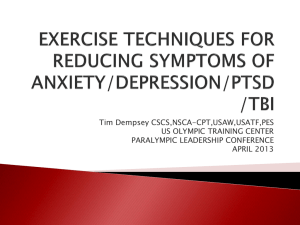Cross Patterning Training Techniques
advertisement
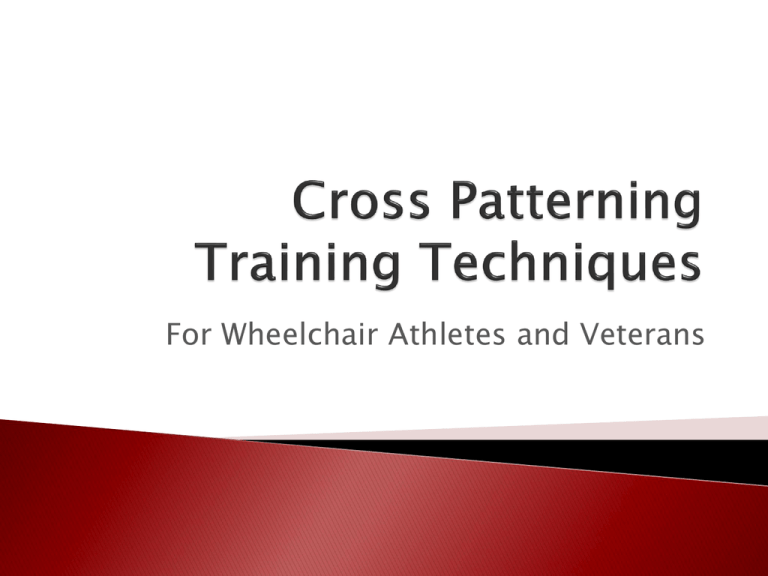
For Wheelchair Athletes and Veterans Tim Dempsey Strength & Conditioning Coach and Personal Trainer at the Riekes Center for Human Enhancement in Menlo Park, California (Paralympic Sport Club Menlo Park) Certified Personal Trainer – National Strength and Conditioning Association Strength and Conditioning Coach – NSCA Performance Enhancement Specialist – National Academy of Sports Medicine Level I Coach – USA Track and Field Club Coach – USA Weightlifting Level 3 Coach and ACL Bridge Certified – Athletic Republic Level I SICCED – Mexican National Coaching System Contact Tim at tdempsey@riekes.org or 650-860-8004 Sharon Kelleher Manager of Communications and Coordinator of Veterans Programs and Adaptive Sports at the Riekes Center for Human Enhancement in Menlo Park, California (Paralympic Sport Club Menlo Park) Paralympian in Wheelchair Tennis, 2000 and 2004. Former #1 in USA and #3 in the world. Contact Sharon at skelleher@riekes.org or 650-298-3404 Cross Patterning: Physical movement that involves crossing the midline of the body, using the upper and lower body, or right and left side separately Definition from Promislow, Sharon. Making the Brain/body Connection - “Each brain hemisphere controls the opposite side of the body. So by intentionally moving an opposite arm and leg across the midfield, we fire off both brain hemispheres at the same time, creating and myelinating better neural connections over the corpus collosum.” p 103 Paraphrasing from Suzana Zuzan, Prague Institute of Rehabilitation: Developmental movement patterns are wired in our DNA, and when we correctly activate those patterns, the body immediately relaxes and movement becomes more fluid. A fundamental energy therapy technique, homolateral patterning exercises are a series of movements that encourage your body's energies to cross over from one side of the body to the other. Walking, or marching in time with your arms swinging freely beside you, are examples of movements that enable your body to maintain its natural balance. Read more: http://www.livestrong.com/article/490133-homolateral-patterningexercises/#ixzz1pyvZvMBI Benefits we have observed in our program participants include decreased pain, improved sports performance, improved range of motion, balance, posture, mental focus and emotional stability. Participants report decreased anxiety levels, decreased depression and improved self-esteem. Traditional movement patterns (squat/lat pull/pull ups/bench press, etc.) are all good exercises, however they may exacerbate problems in certain populations. The familiarity of these movement patterns also encourages the exerciser to go through the movement in “auto mode.” Cross patterning movements require more body awareness and focus, and they enhance the coach/client interaction. Energy therapists say that homolateral repatterning is a key to restoring the communication pathways between the left and right side of your brain. When your energies cross from one side of the body to the other, your body is in balance and your ability to perform physical and mental activities is restored. Read more: http://www.livestrong.com/article/490133homolateral-patterning-exercises/#ixzz1pywjZgj0 Slow cross-lateral movement stimulates the manufacture of dopamine in the frontal lobe of the brain (affecting our ability to see patterns and to learn faster), in the limbic area (controlling our emotions) and in the basal ganglion (intentional movement). (Promislow, Sharon. Making the Brain Body Connection) Anatomy Trains 2nd Edition by Thomas W. Myers Coyle, Daniel. The Talent Code: Greatness Isn't Born. It's Grown. Here's How. New York: Bantam, 2009. Print. Dolen, Carolyn E. Brain Injury Rewiring for Loved Ones: A Lifeline to New Connections. Enumclaw, WA: Idyll Arbor, 2010. Print. Feldenkrais, Moshe. Awareness through Movement: Easy-To-Do Health Exercises to Improve Your Posture, Vision, Imagination, and Personal Awareness. New York: Harper and Row, 1977. Print. Hanna, Thomas. Somatics: Reawakening the Mind's Control of Movement, Flexibility, and Health. Cambridge, MA: Da Capo Life Long, 1988. Print. Hoge, Charles W. Once a Warrior, Always a Warrior: Navigating the Transition from Combat to Home--including Combat Stress, PTSD, and MTBI. Guilford, CT: GPP Life, 2010. Print. Promislow, Sharon. Making the Brain/body Connection: A Playful Guide to Releasing Mental, Physical & Emotional Blocks to Success. West Vancouver, B.C.: Kinetic Pub., 1998. Print. Ratey, John J., and Eric Hagerman. Spark: The Revolutionary New Science of Exercise and the Brain. New York: Little, Brown, 2008. Print. Effect of educational kinesiology on static balance of learning disabled students http://www.ncbi.nlm.nih.gov/pubmed/3211692 http://www.livestrong.com/article/490133-homolateral-patterning-exercises/ Due to repetitive motion, wheelchair athletes often experience injuries to the rotator cuff, impingement, muscle imbalances, carpal tunnel syndrome, neck pain, and elbow strain such as tennis elbow. Strengthening the torso can help alleviate stress on the shoulder joints. In particular, athletes who participate in Tennis, Field Events, Volleyball, Para Canoe, and Hockey can reduce their risk of shoulder injuries by using the torso for added power and rotation. Cross patterning training techniques can increase core strength and range of motion. “More than two thirds of patients (with SCI) reported shoulder pain since the beginning of wheelchair use (6). It is known that the upper extremity pain in subjects with SCI is from muscle imbalance at the shoulder joint. These subjects also have a higher risk of shoulder impingement syndrome (1).” (Turbanski, Stephan, and Dietmar Schmidtbleicher. "Effects of Heavy Resistance Training on Strength and Power in Upper Extremities in Wheelchair Athletes." Journal of Strength and Conditioning Research 24.1 (2010): 8-16. Print.) “A selective 8-week home exercise program is effective in reducing pain and improving function and satisfaction in this population of wheelchair users.” (Nawoczenski, D. A., J. M. Ritter-Soronen, C. M. Wilson, B. A. Howe, and P. M. Ludewig. "Clinical Trial of Exercise for Shoulder Pain in Chronic Spinal Injury." Physical Therapy 86.12 (2006): 1604-618. Print.) “Higher muscle strength and higher functional outcome are related to fewer upper extremity complaints.” (Van Drongelen, S., S. De Groot, H E J. Veeger, E L D. Angenot, A. J. Dallmeijer, M W M. Post, and L H V. Van Der Woude. "Upper Extremity Musculoskeletal Pain during and after Rehabilitation in Wheelchair-using Persons with a Spinal Cord Injury." Spinal Cord 44.3 (2005): 152-59. Print.) Weakness of shoulder adductor muscles was observed in the wheelchair athletes. They further suggest that this weakness may heighten the wheelchair athlete's risk of shoulder impingement, because the stronger abductors may pull the humeral head further up into the subacromial space (Fabrisia Ambrosio, PhD, MPT,1,2 Michael L Boninger, MD,1–3 Aaron L Souza, PhD,1,2 Shirley G Fitzgerald, PhD,1,2 Alicia M Koontz, PhD, ATP,1,2 and Rory A Cooper, PhD1,2. "Biomechanics and Strength of Manual Wheelchair Users." The Journal of Spinal Cord Medicine 2005; 28(5): 407–414. Print.) Wheelchair - alternatively reach arms up wall in a climbing motion Standing - same as above, but add opposite side leg Injury prevention - teaches stabilization of shoulder girdle while reaching overhead Variations - same side terminal point Wheelchair - advance forward with opposite side terminal point Standing - single leg balance on opposite side leg Injury prevention - teaches scapula to move independently (elevation/depression), engages terminal point, elevate through thoracic spine Variations - same side terminal point Wheelchair – opposite arm abducts, terminal point comes forward with same side arm Standing - pulling side glute contracts and presses hip slightly forward Injury prevention - teaches protraction and retraction of scapula, using core to initiate rotational movements Variations - opposite side terminal points contract Wheelchair - reach across centerline, abduct pulling arm around torso Standing – same as above, but load inside side hip and transfer to outside (pulling side) hip Injury prevention - teaches pulling through body, active transfer of load through functional structures rather than passive structures Wheelchair - elevate arm and opposite side terminal point Injury prevention - good warm up Wheelchair - cross arms and terminal point Injury prevention - increases body awareness and improves balance and coordination Wheelchair – depends on upper body strength. If desired, the athlete can get on the ground to perform these exercises. Injury prevention - can improve transfers in wheelchairs, improves shoulder stability by integrating core, teaches movement sequencing Examples: 1. Cross arms and rotate rib cage, shoulders and head same direction. Next, cross arms and rotate rib cage and head one way, shoulders the other way 2. Move rib cage sideways, then move rib cage sideways while elevating same side terminal point. Lastly, move rib cage sideways while elevating opposite side terminal point 3. Pull one shoulder blade downwards. Then pull one shoulder blade downwards while elevating opposite shoulder blade. Next, pull both shoulder blades down. There is limited research on the benefits of Cross Patterning Exercises. At the very least, the exercises improve functional movement patterns and sport specific performance. The psychological and emotional benefits are anecdotal at this point. Further research is needed. We would like to thank the Riekes Center for Human Enhancement and the following individuals for their assistance with this presentation: Gary Riekes – Founder and Executive Director Sagesse Graham – Video Production Ron Curcio – Athletic Fitness Coach The veterans exercise group and other individuals who participated in the exercise demonstration videos

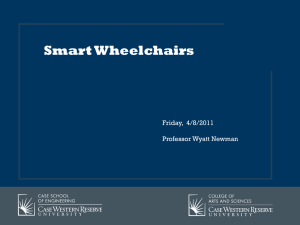
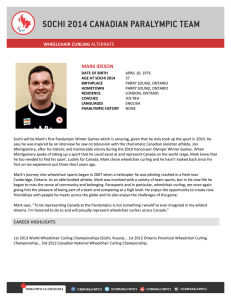
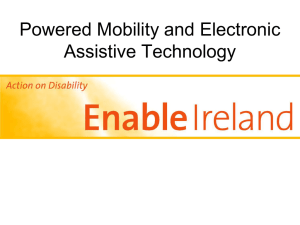

![Full paper [DOC 43 KB]](http://s3.studylib.net/store/data/005838945_1-04e1faa67f9c697009b4a282c6cbcb5e-300x300.png)
